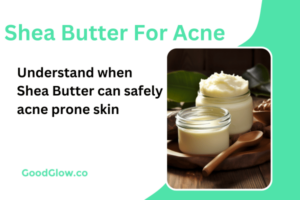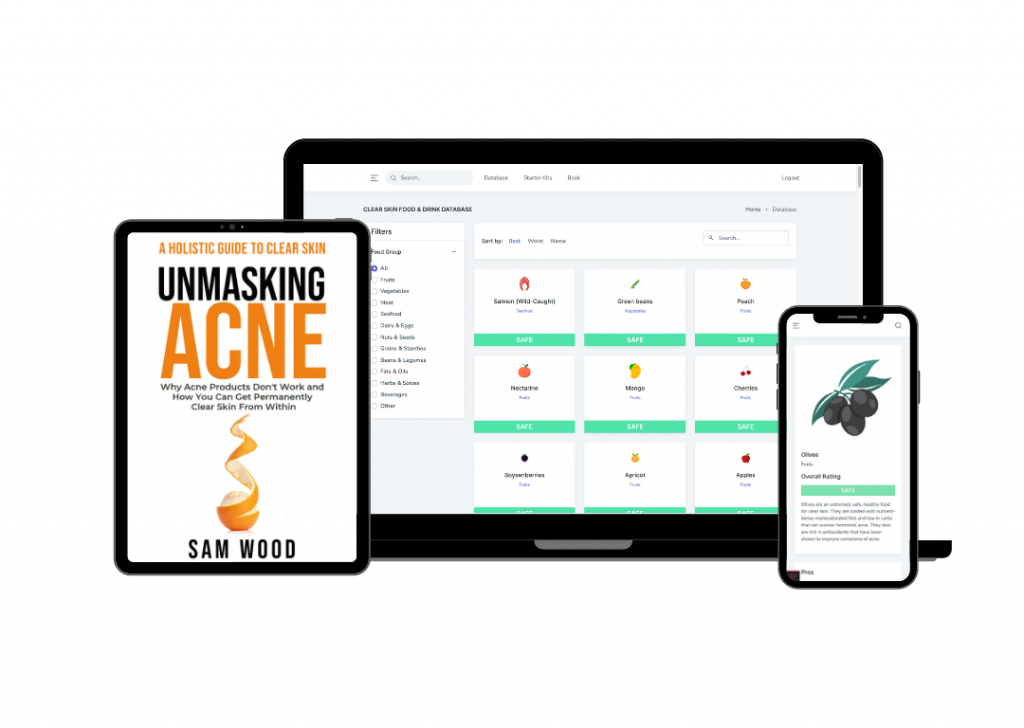Shea butter is widely used in skincare and cosmetics due to its nourishing and moisturizing properties, making it a popular ingredient in products like lotions, creams and lip balm. While the butter is generally considered a luxury skincare ingredient its oily, thick texture make many people with acne prone skin hesitant to try it.
In this article, we’ll review the different varieties of shea butter available, its hydrating characteristics, whether it blocks pores, ability to reduce inflammation and signs of aging, and antifungal properties.
1. There are 3 types of shea butter
There are three primary types of shea butter that are used for cosmetics purposes:
- Raw Shea Butter: Raw shea butter is extracted from the shea nut without any processing. It retains its natural color, smell, and nutrients. This makes it best to use on skin prone to acne for its antibacterial and anti-inflammatory properties.
- Unrefined Shea Butter: Unrefined shea butter goes through minimal processing (like filtering or boiling). It preserves most of its beneficial properties and is a better option for sensitive skin types, as it is free from any chemical additives. However, its minimal processing may leave behind some impurities depending on the quality of the sourcing.
- Refined Shea Butter: Refined shea butter undergoes several stages of processing, including deodorization and bleaching. As a result, its natural nutrients are significantly reduced, and it may contain some additives. Refined shea butter is less effective on pimple breakouts compared to raw or unrefined shea butter.
Ultimately, raw shea butter is the best choice for acne-prone skin as it retains the highest amount of natural nutrients and is least likely to cause any adverse reactions.
2. Shea butter moisturizes and protects the skin
Shea butter has been used for centuries and is known for its ability to hydrate and protect the skin. This is primarily due to its high concentration of fatty acids, such as oleic, stearic, linoleic, and palmitic acids. These fatty acids help to nourish and create a protective barrier on the skin’s surface, sealing in moisture and preventing dryness.
While shea butter’s moisturizing properties are beneficial for dry and sensitive skin types, they can also contribute to blocking pores. This occurs when the oils in shea butter prevent the oxygenation of pores, which can lead to acne breakouts for some individuals. It’s essential to be mindful of how your skin reacts to shea butter and adjust your skincare routine accordingly.
3. Shea butter has a low comedogenic rating
A comedogenic rating measures the likelihood of a skincare product or ingredient causing clogged pores or triggering acne breakouts. Shea butter falls on the low end of the scale, with a rating of 0-2, meaning it is not comedogenic. Because of this, shea butter itself is unlikely to clog pores or cause breakouts without the presence of existing bacteria or other pore causing ingredients.
Please keep in mind that skincare products containing shea butter may also contain other ingredients that could be comedogenic. Examine additional ingredients in skincare products including shea butter before incorporating them into your skincare routine. Make sure to check any skin care product are considering in a pore clogging ingredient checker before purchasing.
4. Shea butter is anti-inflammatory
There are two main compounds that are responsible for Shea Butter’s powerful anti-inflammatory properties: cinnamic acid and lupeol, which make it an effective remedy for soothing blemishes. These compounds work to reduce redness, swelling, and discomfort associated with inflamed skin conditions.
Shea butter is also rich in vitamins A and E, which support skin health by promoting cell regeneration and reducing inflammation. This in turn reduces the likelihood of future breakouts.
5. Shea butter is anti-aging
Shea butter possesses potent anti-aging properties due to its high concentration of antioxidants, including vitamins A and E. These antioxidants combat free radicals (unstable molecules that damage skin cells) and reduce inflammation, both of which can contribute to premature aging.
Additionally, shea butter helps to relieve UV damage and sun spots by promoting skin regeneration, offering a natural solution for maintaining youthful, healthy skin.
6. Shea butter is anti-fungal
Shea butter is safe for fungal acne and people who suffer from skin conditions caused by fungal infections. Its protective and soothing qualities work to treat affected fungal areas, without causing further irritation or worsening the infection.
Is shea butter safe for eczema?
Yes, shea butter is generally safe for eczema. It reduces irritation and is rich in vitamins and fatty acids, which can help hydrate and repair the skin barrier. Patch test before using it as a consistent moisturizing lotion for eczema, as individual sensitivities vary.
Can shea butter fade stretch marks?
Yes, shea butter contains nutrients that have been shown to help alleviate the appearance of stretch marks. Shea butter is rich in vitamins A, E, and F, which helps promote collagen production and skin elasticity. Additionally, the presence of fatty acids, natural antioxidants, and anti-inflammatory properties make it an effective moisturizer and skin protectant.
Regular application of shea butter can contribute to keeping the skin hydrated and nourished, which may gradually reduce the visibility of stretch marks. However, it is important to note that individual results vary, and using shea butter does not guarantee the complete removal of stretch marks.
Consistently use high-quality, unrefined shea butter on the affected areas, and exercise patience, as the process of fading stretch marks can take some time.
What are the best alternatives to shea butter for acne?
For those dealing with acne, it’s crucial to maintain a proper diet, indulge in regular exercise, and utilize non-comedogenic skincare products. Here are some alternative products to shea butter that can help address acne-prone skin:
- Aloe Vera Gel: Rich in vitamins, minerals, and enzymes, aloe vera has soothing and cooling properties, making it a perfect substitute for shea butter.
- Grapeseed Oil: Light and quickly absorbed, grapeseed oil is rich in linoleic and oleic acids, which fight acne.
- Sunflower Seed Oil: High in linoleic acid, sunflower seed oil is non-comedogenic and suitable for skin prone to breakouts.
- Argan Oil: A light oil rich in vitamin E, argan oil is non-comedogenic and helps to balance the skin’s natural oil production.
- Jojoba Oil: Closely mimicking our skin’s sebum, jojoba oil is suitable for acne-prone skin as it helps to regulate oil production.
- Squalane Oil: An excellent moisturizer, squalane oil is derived from sugar cane, olives, or rice bran, making it suitable for all skin types.
- Hemp Seed Oil: Boasting anti-inflammatory properties and high in linoleic acid, hemp seed oil is an ideal oil for blemish-prone skin.
- Neem Oil: Famous for its antibacterial properties, neem oil can help to prevent and treat acne.
- Rosehip Seed Oil: With ample linoleic acid and vitamin A, rosehip seed oil is an excellent option for skin blemishes while also assisting in minimizing scars.
- Tea Tree Oil: Known for its powerful antiseptic properties, tea tree oil can be applied directly on acne breakouts or diluted with a carrier oil for acne prevention.
These non-comedogenic alternatives to shea butter can effectively help manage skin susceptible to acne while providing essential hydration and nourishment.
Precautions and Tests Before Using Shea Butter
Conduct a patch test before using shea butter, especially if you have sensitive skin or a history of allergic reactions. Apply a small amount of the product on a discreet area, like the inner arm, and wait 24 to 48 hours to observe any adverse reactions. It is also recommended to perform a patch test on your face if you plan to use shea butter as a moisturizer.
Although shea butter is generally considered non-comedogenic higher concentrations could potentially clog pores for certain skin types. Ask your dermatologist if you are unsure about the appropriate concentration for your particular skin type or condition, such as eczema or psoriasis.
Remember that everyone’s skin is different, and results vary according to individual sensitivity and specific skin conditions.
Frequently Asked Questions
Is shea butter suitable for acne-prone skin?
Yes, shea butter is generally considered safe in the management of acne. It has a low comedogenic rating, which means it is less likely to clog pores and cause acne breakouts. Remember to patch test any new skincare product, as individual reactions can vary.
How does shea butter compare to other oils like coconut oil?
Shea butter and coconut oil are both popular skincare ingredients, but Shea butter’s lower comedogenic rating, makes it less likely to clog pores than coconut oil. Additionally, shea butter offers more anti-inflammatory benefits, while coconut oil has stronger antimicrobial properties. Both ingredients provide hydration and nourishment for the skin, so your choice ultimately depends on your specific skin needs and preferences.
What are alternatives to shea butter for sensitive skin?
There are alternative products to consider if you find that shea butter is not suitable for your sensitive skin. Three popular options include jojoba oil, squalane, and aloe vera gel. Jojoba oil closely resembles the natural sebum your skin produces, so it is gentle and less likely to irritate. Squalane is a non-comedogenic oil that provides hydration without clogging pores. And aloe vera gel is a soothing, lightweight gel that can provide hydration and calming relief for sensitive skin. Always make sure to do a patch test whenever trying a new skincare product.

